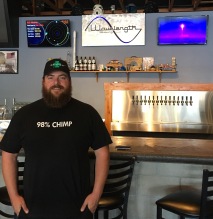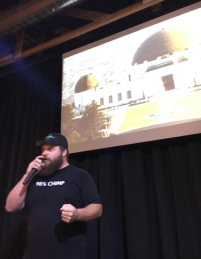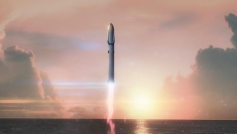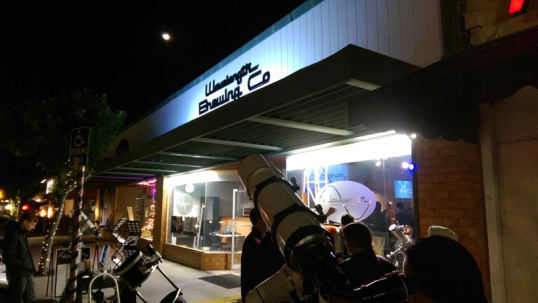Credit: Wavelength Brewing Co.
 By Jonathan Stroud
By Jonathan Stroud
JournalistsForSpace.com
Tasty craft brewed beer, science outreach, and a great space-themed atmosphere begin to describe Wavelength Brewing Company. You won’t find football on the TVs, jerseys on the wall, or light beer posters. Instead, you’ll find a live feed of the International Space Station (ISS) and SpaceX Falcon 9 flags covering the walls. Founded in 2014 by James Petti and Hans Haas with the intent to fuse craft beer with science and technology, the growing brewery is a positive contribution to the downtown Vista Village community. Their tasting room floor selection of craft brew recipes include: Czech Golden Ale, Hibiscus Red, Orange Wheat, and Cascadian Dark Ale.
Find the full Wavelength tap list by clicking here.
Wavelength serves as a hub for like-minded individuals to gather over a pint of beer, share a conversation and enjoy short TED-style talks by guest speakers promoting science outreach.
Notable speakers include Palomar College Astronomy Professor Scott Kardel, Resident Astronomer at the Reuben H. Fleet Science Center Astrophysicist Dr. Lisa Will, and the National Best Seller Spaceflight Historian Francis French, along with other science communicators.
The tasting room also regularly hosts “star-parties” where they allow patrons to explore the night sky. Companies, such as Oceanside Photo and Telescope, bring their high-powered telescopes to cut through the Vista Village light pollution and view distant nebulas, planets, and other objects in the night sky.
Check out previous Wavelength lectures on their YouTube channel by clicking here.
A Craft Brew with Hans Haas
Journalists For Space sat down with current owner, Hans Haas, for an exclusive one-on-one interview to find out more about Wavelength’s craft-brew recipes and science outreach mission. We spoke about his favorite beer, vision for the future, and challenges the brewery faces. He also offered his thoughts on SpaceX’s plans for Mars.

Q: How long have you been brewing beer?
I have brewed for quite a while, almost 10 years. My wife bought me a mail-order home-brew kit and we made it in the kitchen, it fermented out, and it didn’t suck. It wasn’t the best beer we’ve ever made but for the first one, we were like, “Wow, we can make a drinkable beer!”
It just started out as a hobby, something that we would do on the side. I think what took it from home brewing to something that was actually a production-worthy beer was [that] I was more interested in developing a few recipes and repeating them, trying to dial them in, and learn what really can modify taste in a beer… It didn’t really solidify into “Hey, we’re going to open a business” until the thought of combining craft beer with science and technology outreach. We thought it was a novel way to brand and market a brewery. More so than that, it became a worthy cause; you can use craft beer to do some good and help get people excited about the great things humanity is doing.
Q: How many tanks does Wavelength have for brewing?
Six fermenters and one bright tank (where beer is carbonated). You filter it from fermenter, which is where the yeast does its action and turns it into beer, into the bright. Typically brewing to serving takes 2 – 3 weeks for most beers, some of the bigger special beers we do might take longer. There was a 15% malt liquor beer that we made called RP-15, named after rocket fuel, and that sat in the fermenter for over a month.
Q: When did you realize your passion for space and science outreach?

I’ve always been really into it since I was a kid…the typical wanting to be an astronaut and wanting to do all the stereotypical stuff. Then I got into geology. I was 8-years-old running around with a rock-pick trying to find rocks in Valley Center. I’d find a small quartz crystal or a small mica vein, and it was just like “Whoa, this is amazing!” I’d pull out my geology books and identify it. Still played a lot of sports, I did OK academically, but I didn’t set on a course to get a PhD in planetary science or anything. I later got into audio-video, learning how to be a sound engineer requires applying several fields of science. I got a lot of incredible hands-on experience you can’t get in a classroom.
Q: Why did you decide to start Wavelength?
Kind of from the very beginning of thinking about opening a brewery, I wanted to open something that made a positive impact. Not that going out to the bar and having a beer with your buddy isn’t a positive impact, but I wanted something a lot more substantial. I wanted to make something that can go above “just come in and drink a beer,” a place where science-minded people had a gathering spot. There’s a lot of people that were reasonably skeptical that it would work at all, more than one investor told me “What, you’re not going to have sports on the wall? No pictures of light-beer and go out and hire sorority girls from the local college?” That was their advice to me. I felt that you can’t really go half-way; we can’t have the football game on TV next to the latest NASA video. You either have to go 100% into the concept you’re trying to launch or don’t bother. I think that the kind of people that are receptive to what we’re doing would identify a fake right away. If you’re going to be a science-themed brewery and be a place of learning while at the same time serving beer, you have to make sure the science outreach side is solid, genuine, and a good production with qualified, good-people who want to be there.

Q: What’s your favorite Wavelength Brew right now?
I would probably say Redshift is my favorite, but really it depends on the type of day and weather. Although the majority of the recipes are James Petti’s, who is both a head brewer and a founding member of Wavelength, Redshift is one of my old home brew recipes that I know the flavor spot on and it’s a really good one.
Q: What is your vision for Wavelength?
The path forward is to grow the production side, which could very well mean taking it somewhere more accommodating. Wavelength is in a really cool old building but it doesn’t have a loading dock, roll-up doors, or the utility requirements that we would need to brew on a larger scale. So, to grow the production side there will definitely be a warehouse in our future. The side of it I’m really excited about that I envision are satellite tasting rooms or a restaurant. I can see the satellite rooms as a way to extend science outreach in an area or venue, not just a tasting room, something similar with a stage, audio video, and a place for them to come down and present. And of course, you can do star-parties almost anywhere, and I think that’s something we can replicate and put into different neighborhoods. Each neighborhood has its own science enthusiast there and I really think those people would be drawn to it and support it. Through that method, we can make sure there’s a social place for like-minded enthusiasts to gather and talk about science and keep that culture alive and well.
Q: Why are there not more breweries doing science outreach?

I think a lot of people dismiss it right off the bat as something that couldn’t be made profitable and sustain as a business. That’s really just because of what the traditional venues already do, and I get that. In a way it goes against the advice of being conservative and safe, but I didn’t think that it was that risky. I believed the people who would respond to this were out there and they are. There’s a few breweries that are kind of science themed, but they’re more science-fiction; that’s cool too. It seems here and there I’m spotting more places that give a nod to science. Whether it’s how they name a particular beer or how they host events with Ruben H. Fleet Science Center that you didn’t see before. Ruben H. Fleet is great; they’ve been doing science outreach for 45 years so if anyone is the pro at it, it’s definitely them. They do really cool programs called “two scientists walk into a bar” which is really great. They get scientists in pairs and send them out to 25 different places in one night, then you have mainstream pubs and breweries that aren’t normally science-oriented participating in it. It’s amazing and we’re honored to work with them.
Q: What challenges have you and do you currently face with science outreach?

I feel the science outreach is going really well. I’ve gotten presenters in here that are more qualified than I ever thought would have come through the door and would have given us the time of day. Astrophysicists, chemists, cosmologists…it’s an amazing variety and how qualified these people are. In the beginning, one of the challenges was, “Where do I find all these speakers at?”…People that want to come up here at the end of a work day on a Friday and talk to people sitting in a brewery. Now, we have a lot of people that want to participate and want to talk; it was a challenge before but not so much of a problem now.
Another challenge is thinking of new ways to do outreach beyond the presentations, such as star-parties with Oceanside Photo and Telescope (OPT). We’re even going to be doing astrophotography from the sidewalk and that’s another great opportunity to teach people.
Also, anytime you operate a public business you’re going to have people that come in and just aren’t having it, no matter what you do…That’s something I’ve had to deal with in the past. Some people just come in for a beer, they just see “brewery” and as they get to the bar they kind of get this confused look on their face as they order a pint. It doesn’t happen a lot and hasn’t happened in quite a while, but sometimes I’ll be up there doing science-trivia night on a Thursday or something and someone will try to heckle or just say “What do you mean you can’t put the game on” with an attitude. We just smile and say, “Hey, we’re all about science and technology here. This is what we do. If you want a Bud Light and the ball-game there’s only 10,000 other places you can go do that.” But stuff like that you just have to let it go. You’re not going to win all of them.
Although, what offsets that is when people walk in just for a beer and they see a 160ft Falcon 9 rocket land on a drone ship in the middle of the sea on the TV feed and all of a sudden their mind is blown because that wasn’t in the morning news. That wasn’t in their morning newspaper, so they’re just like, “That’s real? That happened?” We tell them this is real, these are the things we’re able to do, and it’s only going to grow from here. Then, two hours later they’re leaving the brewery with an amazing experience and more excited about science and technology than they’ve ever been, and they weren’t even planning on being here for the science. They were just coming in for a beer and ended up leaving a science enthusiast.
Q: What do you think about Elon Musk’s SpaceX plans to send people to Mars?

It’s extremely ambitious but that’s been the case with SpaceX since day one. When they first got a Falcon 1 to put a payload into orbit, that had never been done by a private company before. When they docked with the ISS for the first time, that had never been done by a private company before. Same thing when they landed first-stage back at Cape Canaveral in December, that had never been done before. So Mars is definitely ambitious, but I absolutely believe it’s achievable. I think that Elon is getting better at conveying timelines and what the actual expectations are. That was always the thing before: ambitiously awesome plan, really really ambitious timeline, and they didn’t always hit the timeline, but they would always achieve the goal. I thought it was very wise of him to say if everything goes really well, and things are ideal, we could see this fly in a decade. It’s definitely optimistic, but he communicated that it was an optimistic assessment. So even if we see that system in two decades, a 28-million thrust first-stage…it’s just, I mean, okay I can wait 20-years just to see that fly. Absolutely. That’s four-times the power of a Saturn V, so it’s really exciting.

A lot of people are concerned with the money side of it, asking “how are you going to fund it?” and what not, but there are things that SpaceX is working on that most people don’t take into account in terms of profit streams. They’re working hard to grow their satellite division right now and we don’t hear much about it, but they have a building up in Seattle and they’re hiring like crazy. They have the means to launch their own satellites for an extremely cheap price, especially if you’re doing them as a secondary payload to a paying customer’s primary payload. That’s a huge revenue stream, which will come into being in the next 5-10 years, that I don’t think a lot of people are accounting for. That can obviously help fund the Interplanetary Transport System, so I think they’ll do it. Like he said, 10 years would be absolutely amazing but if it’s 15 or 20 I believe they’ll still get there. I think it’s the most comprehensible and achievable Mars plan that’s been put out there. I absolutely think we will see humans on Mars in our lifetime.
Haas concluded the interview with an inspiring anecdote from Wavelength’s first ever presenter, Astrophysicist Dr. Lisa Will. Haas explained that Dr. Will’s short talk regarding Saturn inspired a young college student to become a volunteer at the Ruben H. Fleet and to eventually change her major to study astrophysics.
According to Haas, “To have played any kind of role in that is just amazing and really helps drive us, that’s really what it’s all about. When you see that kind of result from sharing 20-minutes about Saturn, we want more of that.”
Check out one of Wavelengths science lectures on the video below.
Keep up with more exclusive interviews and space-related content a Journalists For Space.



Wavelength is on my bucket list if I come to your area. I wonder if they sell drinks and food, since it wasn’t mentioned. Great article!
LikeLiked by 1 person
They’re just a tasting room, so no liquor or food.
LikeLiked by 1 person
You can bring food in, though, and local restaurants will deliver to your table.
LikeLiked by 1 person
Great article, loved the piece about the inspiration for one visitor resulting in her changing her major to astrophysics . Definitely a reason to come back and visit the area to go have a beer at this place .
LikeLiked by 1 person